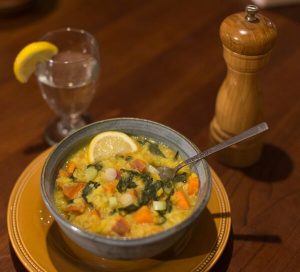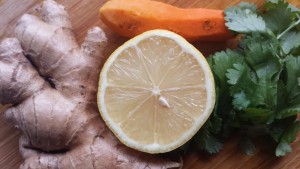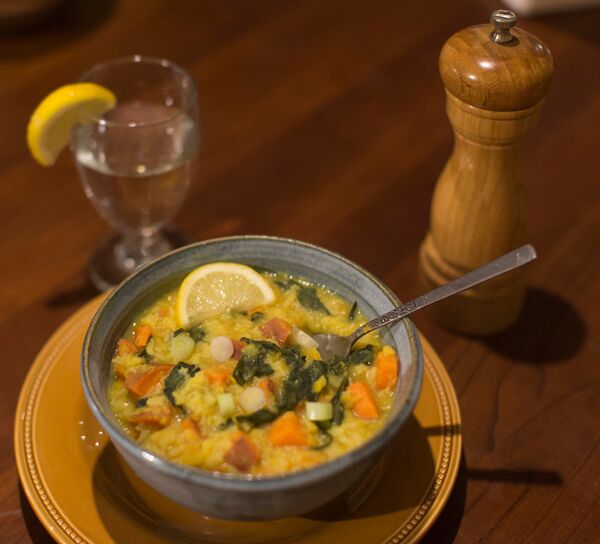 If you are even semi-familiar with the science of Ayurveda it is likely you have heard the term Kitchari being thrown around. Kitchari is an Indian dish commonly used as both food and medicine in Ayurveda; however, this is not your ordinary recipe. This simple, yet powerful food goes much farther than a tasty meal. With a long list of health benefits, uses, and variations, this dish is undoubtably an Ayurvedic essential!
If you are even semi-familiar with the science of Ayurveda it is likely you have heard the term Kitchari being thrown around. Kitchari is an Indian dish commonly used as both food and medicine in Ayurveda; however, this is not your ordinary recipe. This simple, yet powerful food goes much farther than a tasty meal. With a long list of health benefits, uses, and variations, this dish is undoubtably an Ayurvedic essential!
“Let medicine be thy food and food be thy medicine.”
What is Kitchari?
Kitchari is a traditional Indian dish with the main ingredients of mung dal and basmati rice that has been used in Ayurveda for thousands of years. Mung dal is the green mung bean, sliced in half with the outer green skin removed, leaving a small yellow lentil. The process of this allows the bean to cook into a mushy state, making it much easier to digest. Since this is one of the main health benefits of Kitchari, mung dal is often preferred over the whole mung bean when making Kitchari.
Why is Kitchari so revered in Ayurveda?
Kitchari is considered an Ayurvedic staple for several reasons. As mentioned above, the mushy state of the dal and basmati rice allows for easy digestion, even by many individuals that have a hard time digesting other beans. When eating meals such as this, the digestive fire (Agni) can reduce its work load and “take a break”. This (often much needed) break allows the digestion to strengthen and toxins to be flushed from the system.
Kitchari is also considered a “perfect protein” source, meaning it contains the nine essential amino acids that are needed in the body. However, Kitchari’s nutrient value goes much farther than protein. This hearty meal is a great source of numerous essential vitamins and minerals such as iron, calcium, manganese, phosphorus, potassium, magnesium, folate, copper, zinc and various B vitamins. It is a great source of dietary fiber and contains a large amount of anti-aging, cancer-fighting antioxidants. Due to the high nutrition content of Kitchari, it is considered a healthy, nourishing, sustainable meal option to eat on a regular basis (I personally eat Kitchari almost everyday!).
Between these two essential factors, Kitchari is considered a great meal choice for the daily diet, but even more so during times of cold, flu, illness, digestive disorders, pregnancy, and postpartum. It is the single food taken during most Ayurvedic mono-diet cleanses such as the Kitchari Cleanse and the more in depth Panchakarma Therapy. Unlike many other cleanses and fasts, the regular intake of Kitchari allows the body to flush out the toxins while simultaneously providing enough nutrients to avoid extreme weakness and depletion.
Find out how to perform a Kitchari Cleanse here!
Finally Kitchari possesses an unlimited amount of variations to fit your personal needs. Although traditionally Kitchari is created from solely mung dal and basmati rice, many individuals choose to switch up the ingredients for health purposes, doshic needs, seasonal influence, or simply taste preferences. For example, a Vata-Balancing Kitchari will be beneficial for Vata types, during times of Vata imbalance, or for the fall season. Alternatively you may be performing a detox and choose a more typical cleansing Kitchari recipe. Whatever your needs are, there is likely a Kitchari recipe for you!
Health Benefits of Kitchari
- Tri-doshic, meaning it is beneficial for all dosha types (aka Ayurvedic body-types)
- Easy to digest
- Strengthens the digestive fire and flushes toxins when eaten regularly
- Due to the easy-to-digest quality, this is the most recommended meal during sickness, chronic illness, weakness, digestive issues, pregnancy, postpartum and detoxification
- Perfect protein source (contains all 9 essential amino acids)
- High in multiple nutrients such as iron, calcium, potassium, magnesium, folate, copper, zinc, and various B vitamins
- Great source of dietary fiber
- High in cancer-fighting, anti-aging antioxidants
- Nutrient dense, making it a healthy, sustainable routine meal option
- Improves heart and colon health
- Spices involved provide numerous health benefits such as reducing inflammation, flushing toxins, increasing circulation, boosting immunity, increasing the digestion, and allowing better absorption of nutrients (see a full list of the health benefits of common spices here)
- Great meal option for weight loss programs (especially Kapha-reducing variations)
- Wide variety of recipe options to adhere to the individual’s healthcare needs
Discover our full list of Kitchari recipes here!
When is the best time to eat Kitchari?
Kitchari is very versatile and can basically be eaten at anytime. It is for suitable daily intake, as it is healthy, nourishing, energizing, great for the digestion, an excellent protein source, and has many recipe variations to adhere to your current needs on any given day.
Whether you choose to make Kitchari a routine staple in your diet or not, it should at least be a mandatory part of your protocol during times of sickness (fever, flu, cold, etc), chronic illness, digestive disorder, cleansing, pregnancy, and postpartum. This is because during all of these stages of life, the digestive fire becomes very weak and therefore only simple foods should be taken. But as mentioned above, Kitchari will not only give your digestion a rest, it will provide you with plenty of essential vitamins and nutrients that will strengthen, nourish, and rejuvenate the body during these crucial times.
Get our Get Well Kitchari recipe here!
How do you make Kitchari?
Kitchari is very simple to make. It generally requires the addition of water, beans, rice, spices, oil, and vegetables into one pan and cooked on a low simmer for long enough to make a mushy stew or soup of sorts. The cooking process generally will take about 30 to 45 minutes total.
There are a plethora of Kitchari recipe variations and therefore you can pick and choose the ones that will best suit your needs on any given day. Some may be a bit more involved and others will be easier depending on the ingredients and the chosen method for cooking. No matter what the recipe, Kitchari is fairly easy to make even for the novice.
Although traditional Kitchari is made with mung dal and basmati rice, often you can use replacements such as using red lentils or whole mung beans rather than the mung dal. Generally Kapha types have issues with metabolizing refined grains and therefore may choose to use quinoa or millet in place of the basmati rice. During cleanses it is often recommended to avoid adding in veggies and using strictly the mung dal, bastmati rice, digestive spices, and lots of ghee. However, a wide variety of vegetables can be used to make it more interesting, adjusting the selection to the season (e.g. zucchini, yellow squash, and cilantro for summer) and your current healthcare needs (e.g. beets, carrots, kale, and dandelion greens for liver support).
Classic Cleansing Kitchari Recipe

Ingredients
- 1/2 teaspoon cumin seed, whole
- 1/2 teaspoon brown mustard seed, whole (omit for Pitta)
- 1/2 teaspoon freshly ground black pepper
- 2 teaspoons Agni Churna*
- 1/8 teaspoon cayenne pepper (optional, omit for Pitta)
- 1/4 cup minced onion
- 1 teaspoon finely minced serrano pepper (optional, omit for Pitta)
- 2 tablespoons finely minced ginger
- 2 tablespoons ghee
- 1 cup split mung dal
- 3/4 cup basmati rice (use quinoa for Kapha)
- 6 cups water
- 1/3 cup thinly sliced carrot
- 1/2 cup thinly sliced celery
- 1 cup chopped kale leaves, stemmed
- 1/4 cup finely chopped cilantro
- 1/2 lemon, juiced (use lime for Pitta)
- 3/4 teaspoon salt
- Lemon wedges, for garnish (use lime for Pitta)
- Chopped green onion, for garnish
- Ghee, for individual servings
*Replace the Agni Churna with 1 teaspoon turmeric, 1/4 teaspoon cumin powder, and 1/4 teaspoon fennel powder.
Click here for a printable copy of this recipe.
Directions
1. Measure the spices, chop the onion, and mince the serrano (if used) and fresh ginger.
2. Heat a large sauce pan over medium heat and add in the ghee. Once hot, add in the onion, cumin, brown mustard seed, and black pepper. Stir over a medium heat for 2 minutes.
3. Add in the fresh ginger, serrano pepper (if used), cayenne pepper (if used), and Agni Churna. Sauté for an additional 30 seconds stirring constantly.
4. Add in the water and bring it to a boil over high heat.
5. Once boiling, reduce the heat to low-medium and add in the mung dal. Cover the pan, leaving a slight opening to prevent overflow. Cook for 15 minutes, stirring half way.
6. As the beans are cooking, begin to slice up the carrot, celery, and kale.
7. Add in the rice, carrot, celery, and kale to the pot. Stir well and cover the pan, keeping it slightly cracked. Continue to cook for 15 minutes, stirring every 3 to 4 minutes. If the kitchari becomes too thick, carefully add more water by the quarter cup.
8. Reduce the heat to low, cover the pan completely and cook for a remaining 3 minutes. Stir every minute to avoid the kitchari sticking to the bottom of the pan.
9. Turn off the heat and take the pan off of the hot burner. Add in the cilantro, fresh lemon juice, and salt. Stir well to blend all of the ingredients together evenly. Cover the pan and let it sit for a few minutes to allow the flavors to harmonize.
10. Serve into bowls. For added cleansing effects, garnish generously with extra cilantro, lemon juice (lime for Pitta), and ghee. Add more salt and pepper if needed.
11. Kitchari is best the first day, however, it will keep for up to 3 to 5 days in the refrigerator. Reheat over a low heat and add in 1/4 cup of water, 1 teaspoon of ghee, fresh lemon juice, cilantro, and a dash of salt and pepper with each serving.
Click here for a printable copy of our Cleansing Kitchari recipe.
Savor this meal as your lunch, dinner or as a mono-diet during illness or a cleanse. It is easy to make, tasty, nourishing, great for the digestion and suitable for every-body. So eat up and enjoy my friends!!!



Hello
Thank you for your post
I add garlic and chilli . Why is this not included in the recipe ? Is there a reason to avoid them ?
Thank you
Mimi
Hi Mimi,
Thank you for writing in! The garlic and chili are both increasing for Pitta and secondary to Vata. They are great additions when dealing with Kapha imbalances, but are far from “tri-doshic” which is the intent for this particular cleansing Kitchari recipe. As I mentioned in the article, there are so many Kitchari variations and if these ingredients work well for you, then there is no reason to avoid them. They are very tasty additions and also possess many health benefits. I often use a bit of chili myself, although I find the garlic does not digest well for me personally. As always it is essential to listen to your body, rather than a general recommendation. Thank you for your question!
Namaste,
Danielle
thank you so much for replying Danielle . Loved reading your post. I am trying to balance Kapha as I have sinus issues and polyps in my nose . Garlic and ginger and also chillis were recommended to me
Keep up the love
x Mimi x
Thank you for underlining that a kitchari cleanse is great for those who are looking to flush out toxins and have their digestive system function properly. My wife and I are planning to go on a detox, but we have a penchant for Indian cuisine. Now that I know kitchari is an excellent detox, I will share this with my wife.
Hi Kristofer,
Thank you for sharing! I am so happy to hear you found this information useful and will be using Kitchari for your upcoming detox. It is really effective and I hope it suits you and your wife well. Please reach out if you have any questions!
Best of luck on your cleanse!
Namaste,
Danielle